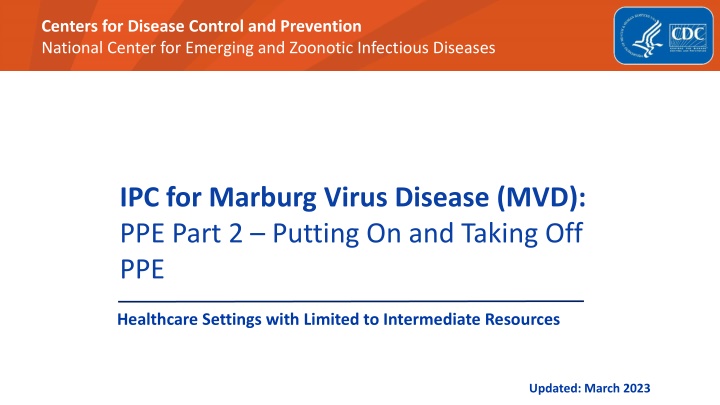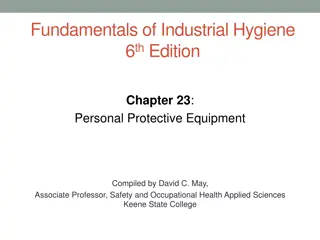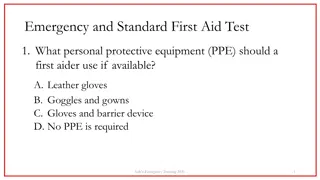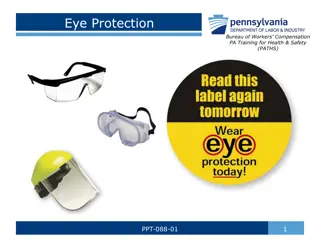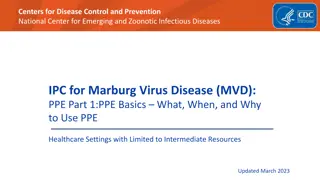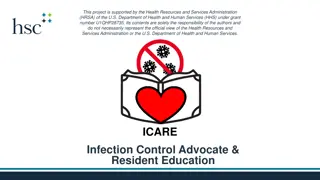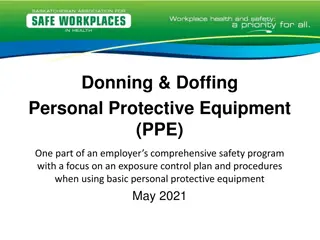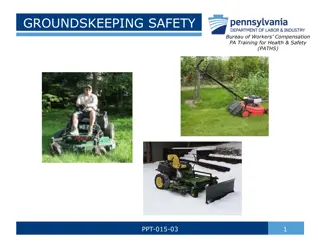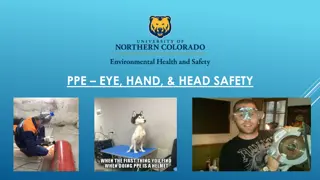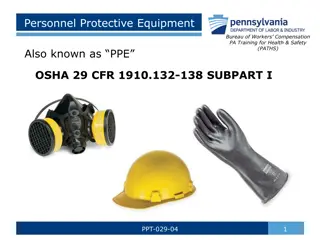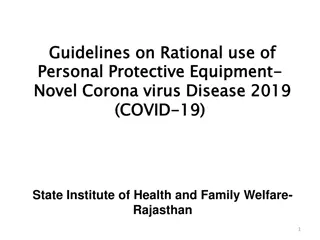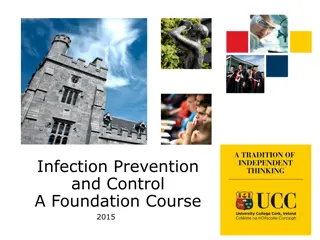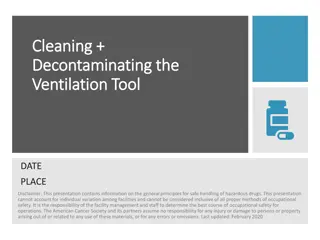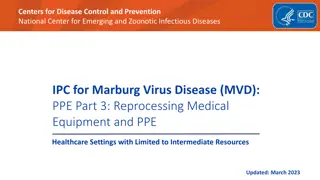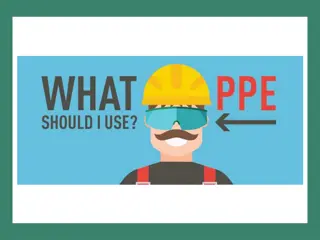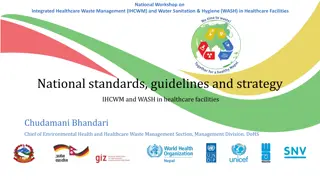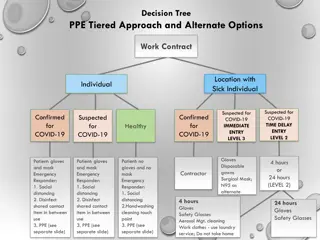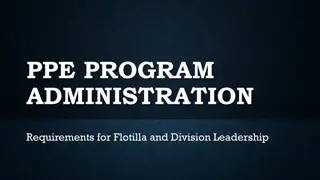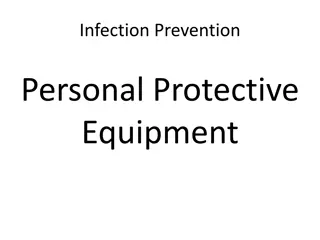Proper Use of Personal Protective Equipment (PPE) in Healthcare Settings
This resource from the Centers for Disease Control and Prevention provides guidance on the correct procedures for putting on and taking off PPE in healthcare settings with limited to intermediate resources in the context of Marburg virus disease. It emphasizes the importance of using PPE as a barrier to prevent the spread of infectious diseases through direct contact with body fluids. The content covers learning objectives, reasons for using PPE, recommendations for PPE use, key points on PPE effectiveness, and instructions for donning and doffing PPE. Additionally, it offers access to videos demonstrating proper PPE procedures.
Download Presentation

Please find below an Image/Link to download the presentation.
The content on the website is provided AS IS for your information and personal use only. It may not be sold, licensed, or shared on other websites without obtaining consent from the author.If you encounter any issues during the download, it is possible that the publisher has removed the file from their server.
You are allowed to download the files provided on this website for personal or commercial use, subject to the condition that they are used lawfully. All files are the property of their respective owners.
The content on the website is provided AS IS for your information and personal use only. It may not be sold, licensed, or shared on other websites without obtaining consent from the author.
E N D
Presentation Transcript
Centers for Disease Control and Prevention National Center for Emerging and Zoonotic Infectious Diseases IPC for Marburg Virus Disease (MVD): PPE Part 2 Putting On and Taking Off PPE Healthcare Settings with Limited to Intermediate Resources Updated: March 2023
Learning Objectives Learning Objectives After this presentation, participants will be able to Explain why carefully putting on and taking off PPE is important in the context of Marburg virus disease Describe at least three considerations for putting on PPE correctly in the context of Marburg virus disease. Describe at least three considerations for taking off PPE correctly in the context of Marburg virus disease.
Why PPE? Why PPE? Marburg virus disease can spread through direct contact (such as through broken skin or mucous membranes in the eyes, nose, or mouth) with Blood or body fluids Objects contaminated with blood or body fluids PPE works as a barrier to protect your eyes, nose, mouth, skin, and clothing from contact with a patient s body fluid keeping you and those around you safe.
Discuss Discuss Based on what you already know about PPE use, what recommendations would you give this man in the red shirt to help him better protect himself and others?
PPE Key Point PPE can protect you from infection but PPE only works if it is used correctly every time.
Definition: Donning & Doffing Definition: Donning & Doffing Donning = putting on an article of clothing Doffing = taking off an article of clothing https://phil.cdc.gov//PHIL_Images/18351/18351_lores.jpg
Exactly how to don and doff PPE depends on the specific PPE items available. PPE Donning & Doffing Videos The link below provides videos on donning and doffing: https://www.cdc.gov/vhf/ebola/hcp/ppe- training/index.html
Donning Donning PPE: Notes PPE: Notes Before donning PPE Wear dedicated clothing or garments that can be replaced or laundered (e.g., scrubs) Take off jewelry and accessories Perform hand hygiene Check for tears and other damage in PPE that could reduce effectiveness Donning a gown Secure at neck and waist with ties
Donning Donning PPE: Notes PPE: Notes ( (continued continued) ) Face mask Place mask over nose, mouth, and chin Fit flexible nose piece over bridge of nose Adjust to fit Face shield or goggles Place over face and eyes Adjust to fit Gloves Inner pair of gloves goes under cuff of gown Outer pair of gloves goes over cuff of gown
When to Doff PPE When to Doff PPE Change PPE if it becomes Heavily contaminated with blood or body fluids Damaged (e.g., glove tears, gown rips) Take off PPE after Caring for patients Before leaving the isolation area In the designated doffing location Completing waste management or environmental cleaning tasks
Key Points for Doffing PPE Key Points for Doffing PPE Risk of self-contamination is very high when removing PPE Potential for contamination from PPE to hands and from hands to mucous membranes, clothing, and skin The outside of PPE should not touch your skin or any other body part Remove PPE slowly and carefully Remove outermost PPE first It is likely to be the most contaminated (e.g., outer gloves)
Doffing PPE: Notes Doffing PPE: Notes Gloves Pinch one glove at wrist and peel away from hand, allowing glove to turn inside out Hold removed glove in other hand and slide fingers of ungloved hand inside wrist area; remove by rolling down and folding inside out Gown Break knot around neck and side Grasp external front shoulders and pull forward slowly Pull away from body and fold inside out as you remove Avoid touching outside of gown to body
Doffing PPE: Notes Doffing PPE: Notes (continued) Face shield or goggles Remove from back by lifting head band or earpieces Keep eyes closed Discard (or, if reusable, place in appropriate bin for reprocessing) (continued) Avoid touching front of face shield or goggles, which may be contaminated Mask or respirator Grasp bottom of strap and lift over head (or untie bottom strap) Lift off top strap or tie Bring forward off face Discard Avoid touching front of mask or respirator, which may be contaminated
Doffing PPE: Waste Disposal Doffing PPE: Waste Disposal Disposable PPE (e.g. face masks, disposable gloves) Biohazard waste bin Biohazard waste bin (can be yellow or red) PPE to be reprocessed (e.g. goggles, rubber boots) Bucket Bucket for dirty, reusable PPE to be reprocessed
Doffing PPE: Hand Hygiene Doffing PPE: Hand Hygiene When to Perform Hand Hygiene After every item of PPE you take off After completely doffing PPE, when your hands are bare
Knowledge Check: PPE Knowledge Check: PPE If you saw a co-worker taking off their gloves like this, what suggestion could you make to help them do this more safely?
Feedback: PPE Feedback: PPE Incorrect method to remove gloves (risk of splashing) Grasp glove at wrist/palm and carefully roll inside out
Reflection Reflection What challenges have you experienced with donning and doffing PPE properly in the past? Do you expect to have similar challenges with PPE for Marburg virus disease? How can those challenges be overcome?
Key Takeaways Key Takeaways PPE helps protect you from infection. Protecting yourself helps protect your patients, co-workers, family, and friends. But PPE only works if it is worn and removed correctly.
Thank you! Thank you! For more information, contact CDC 1-800-CDC-INFO (232-4636) TTY: 1-888-232-6348 www.cdc.gov The findings and conclusions in this report are those of the authors and do not necessarily represent the official position of the Centers for Disease Control and Prevention.
